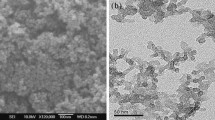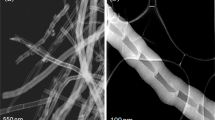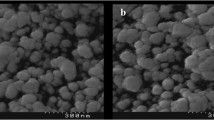Abstract
Carbon aerogels have excellent potential to act as reinforcements for improving the material properties of polymer-based composites because of their porous nanostructures and large surface areas. However, the addition of carbon aerogels to polymer-based composites has effects on the material properties of the final composites, and those effects are not clear. In this study, an epoxy matrix was modified with carbon aerogel, and this modified matrix was then used to manufacture carbon fiber-reinforced polymer (CFRP) laminates. The effects of the addition of the carbon aerogel to the laminates on the mechanical properties and delamination resistance were investigated. The modulus and strength of the laminates were slightly increased by the addition of the aerogel to the composite laminates. The addition of the aerogel to the laminates led to an appreciable improvement in the interfacial property and adhesion between the fibers and matrix, and consequently, the delamination fracture energy was increased. The Mode I delamination fracture energy was measured to be 265 J m−2 for the laminate with the unmodified matrix, whereas that of the laminate with 0.1 wt% aerogel was 346 J m−2. The delamination fracture energy caused by Mode II loading was increased from 655 J m−2 for the unmodified laminate to 1088 J m−2 for laminate modified with 0.5 wt% aerogel. Fractographic observation showed significant differences in the fracture surface morphology between aerogel-modified and unmodified CFRP laminate.












Similar content being viewed by others
References
Ram A (1997) Fundamentals of polymer engineering. Plenum Press, New York
Kinlcoh AJ (1987) Adhesion and adhesive: science and technology, 1st edn. Chapman and Hall, London
Chawla KK (2012) Composite materials: science and engineering. Springer, New York
Kinloch AJ, Shaw SJ, Tod DA, Hunston DL (1983) Deformation and fracture behavior of a rubber-toughened epoxy: 1 microstructure and fracture studies. Polymer 24:1341–1354
Kinloch AJ, Hunston DL (1986) Effect of volume fraction of dispersed rubbery phase on the toughness of rubber-toughened epoxy polymers. J Mater Sci Lett 5:1207–2109
Imanaka M, Nakamura Y, Nishimura A, Iida T (2003) Fracture toughness of rubber-modified epoxy adhesive: effect of plastic deformability of matrix phase. Compos Sci Technol 63:41–51
Imamaka M, Motohashi S, Nishi K, Nakamura Y, Kimoto M (2009) Crack-growth behavior of epoxy adhesives modified with liquid rubber and cross-linked rubber particles under Mode I loading. Int J Adhes Adhes 29:45–55
Lee DB, Ikeda T, Miyazaki N, Choi NS (2002) Damage zone around crack tip and fracture toughness of rubber-modified epoxy resin under mixed-mode conditions. Eng Fract Mech 69:1363–1375
Johnsen BB, Kinloch AJ, Taylor AC (2005) Toughness of syndiotactic polystyrene/epoxy polymer blends: microstructure and toughening mechanisms. Polymer 46:7352–7369
Kinloch AJ, Yuen ML, Jenkins SD (1993) Thermoplastic-toughened epoxy polymers. J Mater Sci 29:3781–3791. doi:10.1007/BF00357349
Brooker RD, Kinloch AJ, Taylor AC (2010) The morphology and fracture properties of thermoplastic-toughened epoxy polymers. J Adhes 86:726–741
Nicolasi L, Guerra G, Migliaresi C, Nicolasi L, Benedetto ATD (1981) Mechanical properties of glass-bead filled polystyrene composites. Composites 12:33–37
Lee J, Yee AF (2000) Fracture of glass bead/epoxy composites: on micro-mechanical deformations. Polymer 41:8363–8373
Kawaguchi T, Pearson RA (2003) The effect of particle-matrix adhesion on the mechanical behavior of glass filled epoxies. Part 2. A study on fracture toughness. Polymer 44:4239–4247
Hsieh TH, Kinloch AJ, Masania K, Taylor AC, Sprenger S (2010) The mechanisms and mechanics of the toughening of epoxy polymers modified with silica nanoparticles. Polymer 51:6284–6294
Hsieh TH, Kinloch AJ, Masania K, Lee JS, Taylor AC, Sprenger S (2010) The toughness of epoxy polymers and fibre composites modified with rubber microparticles and silica nanoparticles. J Mater Sci 45:1193–1210. doi:10.1007/s10853-009-4064-9
Conradi M, Zorko M, Kocijan A, Verpoest I (2013) Mechanical properties of epoxy composites reinforced with a low volume fraction of nanosilica fillers. Mater Chem Phys 137:910–915
Ho MW, Lam CK, Lau KT, Ng DHL, Hui D (2006) Mechanical properties of epoxy-based composites using nanoclays. Compos Struct 75:415–421
Eesaee M, Shojaei A (2014) Effect of nanoclays on the mechanical properties and durability of novolac phenolic resin/woven glass fiber composite at various chemical environments. Compos Part A 63:149–158
Zappalorto M, Salviato M, Quaresimin M (2013) Mixed mode (I+II) fracture toughness of nanoclay nanocomposites. Eng Fract Mech 111:50–64
Shen MY, Chang TY, Hsieh TH, Li YL, Chiang CL, Yang H, Yip MC (2013) Mechanical properties and tensile fatigue of graphene nanoplatelets reinforced polymer nanocomposites. J Nanomater 2013:1–9
Wang PN, Hsieh TH, Chiang CL, Shen MY (2015) Synergetic effects of mechanical properties on graphene nanoplatelet and multiwalled carbon nanotube hybrids reinforced epoxy/carbon fiber composites. J Nanomater 2015:1–9
Ahmadi-Moghadam B, Taheri F (2015) Influence of graphene nanoplatelets on modes I, II, and III interlaminar fracture toughness of fiber-reinforced polymer composites. Eng Fract Mech 143:97–107
Yeh MK, Tai NH, Liu JH (2006) Mechanical behavior of phenolic-based composites reinforced with multi-walled carbon nanotubes. Carbon 44:1–9
Yeh MK, Tai NH, Liu YJ (2008) Mechanical properties of phenolic-based nanocomposites reinforced by multi-walled carbon nanotubes and carbon fibers. Compos Part A 39:677–684
Tai NH, Yeh MK, Peng TH (2008) Experimental study and theoretical analysis on the mechanical properties of SWNTs/phenolic composites. Compos Part B 39:926–932
Yeh MK, Hsieh TH, Tai NH (2008) Fabrication and mechanical properties of multi-walled carbon nanotubes/epoxy nanocomposites. Mater Sci Eng A 483–484:289–292
Hsieh TH, Kinloch AJ, Taylor AC, Kinloch IA (2011) The effect of carbon nanotubes on the fracture toughness and fatigue performance of a thermosetting epoxy polymer. J Mater Sci 46:7525–7535. doi:10.1007/s10853-011-5724-0
Bal S (2010) Experimental study of mechanical and electrical properties of carbon nanofiber/epoxy composites. Mater Des 31:2406–2413
Pekala RW (1989) Organic aerogels from the polycondensation of resorcinol with formaldehyde. J Mater Sci 24:3221–3227. doi:10.1007/BF01139044
Frackowiak E, Beguin F (2001) Carbon materials for the electrochemical storage of energy in capacitors. Carbon 39:937–950
Lee YJ, Park HW, Park S, Song IK (2012) Electrochemical properties of Mn-doped activated carbon aerogel as electrode material for supercapacitor. Curr Appl Phys 12:233–237
Li J, Wang X, Huang Q, Gamboa S, Sebastian PJ (2006) Studies on preparation and performances of carbon aerogel electrodes for the application of supercapacitor. J Power Sour 158:784–788
Qin CL, Lu X, Yin GP, Bai XD, Jin Z (2009) Activated nitrogen-enriched carbon/carbon aerogel nanocomposites for supercapacitor applications. Trans Nonferr Met Soc 19:738–742
Mirzaeian M, Hall PJ (2009) Preparation of controlled porosity carbon aerogels for energy storage in rechargeable lithium oxygen batteries. Electrochim Acta 54:7444–7451
Jiang S, Zhang Z, Lai Y, Qu Y, Wang X, Li J (2014) Selenium encapsulated into 3D interconnected hierarchical porous carbon aerogels for lithium-selenium batteries with high rate performance and cycling stability. J Power Sour 267:394–404
Zhang Z, Jiang S, Lai Y, Li J, Song J, Li J (2015) Selenium sulfide@mesoporous carbon aerogel composite for rechargeable lithium batteries with good electrochemical performance. J Power Sour 284:95–102
Smirnova A, Dong X, Hara H, Vasiliev A, Sammes N (2005) Novel carbon aerogel-supported catalysts for PEM fuel cell application. Int J Hydrogen Energy 30:149–158
Zhu H, Guo Z, Zhang X, Han K, Guo Y, Wang F, Wang Z, Wei Y (2012) Methanol-tolerant carbon aerogel-supported Pt-Au catalysts for direct methanol fuel cell. Int J Hydrogen Energy 37:873–876
Marie J, Chenitz R, Chatenet M, Berton-Fabry S, Cornet N, Achard P (2009) Highly porous PEM fuel cell cathodes based on low density carbon aerogels as Pt-support: experimental study of the mass-transport losses. J Power Sour 190:423–434
Yang X, Sun Y, Shi D, Liu J (2011) Experimental investigation on mechanical properties of a fiber-reinforced silica aerogel composite. Mater Sci Eng A 528:4830–4836
Hsieh TH, Huang YS, Shen MY (2015) Mechanical properties and toughness of carbon aerogel/epoxy polymer composites. J Mater Sci 50:3258–3266. doi:10.1007/s10853-015-8897-0
Hsieh TH, Liang CH (2014) Improvement of impact absorbed energy of CFRPs on adding the nanoparticles into epoxy resins. J Chem Chem Eng 8:692–697
ASTM D3171 (2015) Standard test methods of constituent content of composite materials. ASTM, West Conshohocken
ASTM D3039 (2014) Standard test method for tensile properties of polymer matrix composite materials. ASTM, West Conshohocken
ASTM D3410 (2016) Standard test method for compressive properties of polymer matrix composite materials with unsupported gage section by shear loading. ASTM, West Conshohocken
ISO-15024 (2001) Fiber-reinforced plastic composites—determination of mode I interlaminar fracture toughness, G IC, for unidirectionally reinforced materials. ISO, Geneva
Willams JG (1987) Large displacement and end block effects in the DCB interlaminar test in Mode I and Mode II. J Compos Mater 21:330–347
ISO-15114 (2014) Fiber-reinforced plastic composites—determination of mode II fracture resistance for unidirectionally reinforced materials using the calibrated end-loaded split (C-ELS) test and an effective crack length approach. ISO, Geneva
Blanco J, Garcia EJ, Villoria RG, Wardle BL (2009) Limiting mechanisms of Mode I interlaminar of composites reinforced with aligned carbon nanotubes. J Compos Mater 43:825–841
Zare Y (2015) Effects of interphase on tensile strength of polymer/CNT nanocomposites by Kelly-Tyson theory. Mech Mater 85:1–6
Acknowledgement
The authors would like to thank the Ministry of Science and Technology, Taiwan, for financially supporting this research under Contract Nos. MOST-103-2221-E-151-017 and MOST-104-2221-E-151-057.
Author information
Authors and Affiliations
Corresponding author
Rights and permissions
About this article
Cite this article
Hsieh, TH., Huang, YS. The mechanical properties and delamination of carbon fiber-reinforced polymer laminates modified with carbon aerogel. J Mater Sci 52, 3520–3534 (2017). https://doi.org/10.1007/s10853-016-0646-5
Received:
Accepted:
Published:
Issue Date:
DOI: https://doi.org/10.1007/s10853-016-0646-5




